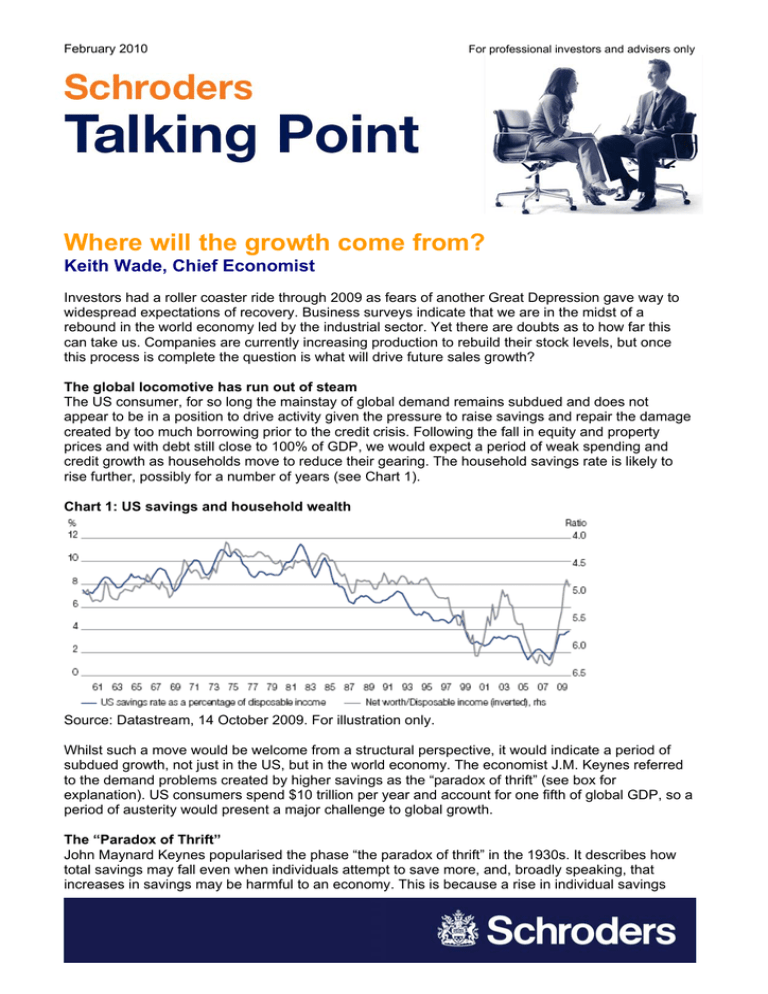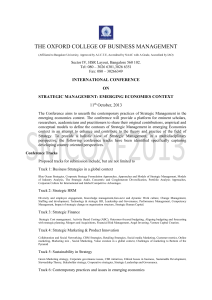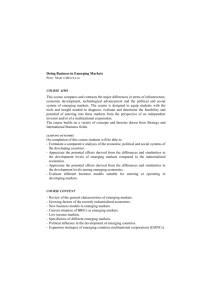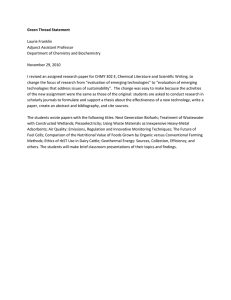Where will the growth come from? Keith Wade, Chief Economist
advertisement

February 2010 For professional investors and advisers only Where will the growth come from? Keith Wade, Chief Economist Investors had a roller coaster ride through 2009 as fears of another Great Depression gave way to widespread expectations of recovery. Business surveys indicate that we are in the midst of a rebound in the world economy led by the industrial sector. Yet there are doubts as to how far this can take us. Companies are currently increasing production to rebuild their stock levels, but once this process is complete the question is what will drive future sales growth? The global locomotive has run out of steam The US consumer, for so long the mainstay of global demand remains subdued and does not appear to be in a position to drive activity given the pressure to raise savings and repair the damage created by too much borrowing prior to the credit crisis. Following the fall in equity and property prices and with debt still close to 100% of GDP, we would expect a period of weak spending and credit growth as households move to reduce their gearing. The household savings rate is likely to rise further, possibly for a number of years (see Chart 1). Chart 1: US savings and household wealth Source: Datastream, 14 October 2009. For illustration only. Whilst such a move would be welcome from a structural perspective, it would indicate a period of subdued growth, not just in the US, but in the world economy. The economist J.M. Keynes referred to the demand problems created by higher savings as the “paradox of thrift” (see box for explanation). US consumers spend $10 trillion per year and account for one fifth of global GDP, so a period of austerity would present a major challenge to global growth. The “Paradox of Thrift” John Maynard Keynes popularised the phase “the paradox of thrift” in the 1930s. It describes how total savings may fall even when individuals attempt to save more, and, broadly speaking, that increases in savings may be harmful to an economy. This is because a rise in individual savings 1 February 2010 means that people are spending less on the goods and services that drive economic performance (and economic performance ultimately dictates the amount people have available to save). Producers and consumers During the boom years the world economy developed around US demand, with countries often being divided into ‘producers’ and ‘consumers’. The former being the exporting economies of the emerging markets primarily China, plus Japan and Germany from the developed world, who would sell to consumers in economies like the US and the UK where asset prices, credit and spending were booming. This pattern is reflected in the trade balances of the different regions with a focus on the US deficit and Chinese surplus (see Chart 2). Chart 2: External trade balances in the US and China Source: Datastream, 14 October 2009. For illustration only. Can the emerging economies pick up the baton? The obvious place to look for a replacement for the US consumer would be the emerging world, particularly China. Whilst the developed world has been through its greatest recession for more than fifty years the emerging market economies led by Brazil, Russia, India and China (the BRICs) have continued to grow. For calendar year 2009, we expect the emerging markets to have recorded growth of about 1.0% compared to a fall of approximately 3.5% for their developed Organisation for Economic Co-operation and Development (OECD) counterparts. One consequence of such outperformance has been an increase in the political standing of the emerging countries. For example the BRICs (along with other emerging countries) are now regularly invited to discuss and co-ordinate global economic policy with their OECD counterparts. The G-20 has displaced the G-7 as the main forum for international policy making. No credit crunch in Asia or Latin America Underlying this is the fact that many emerging market countries were in better shape going into the crisis in terms of their banking sectors, gearing and dependence on foreign capital. Banks in Asia and Latin America avoided much of the exposure to sub-prime and credit structures that brought the sector down in the US and much of Europe. There are exceptions: Central and Eastern Europe has been hit badly by the crisis as these economies did rely heavily on leverage and overseas lenders during the boom years. Overall, though the emerging market economies were well prepared for the crisis and have been able to recover more rapidly. Going back further, such an outcome was largely the legacy of the crisis of 1997/98. Having become overextended in the mid-1990s, the emerging economies (primarily those in Asia) experienced a deep recession after capital inflows reversed and currencies collapsed. In many cases, the International Monetary Fund (IMF) was called in and restrictive policies imposed, involving tight controls on spending and often a restructuring of the corporate sector. This experience left many, particularly in Asia, with a strong desire to reduce their dependence on overseas capital. 2 February 2010 Consequently, trade surpluses and foreign exchange reserves grew rapidly while the banking sector was kept on a tight leash. Savings glut Some believe that the subsequent build up of savings in the emerging world contributed to the subprime lending debacle. China’s recycling of its current and capital account surpluses through the US Treasury market is believed to have depressed yields in the US and boosted liquidity in the banking sector. It’s argued by some that this encouraged banks to become ever more reckless in their lending practices as they strived to earn an acceptable return on their bloated capital reserves. This may be true, but it does not necessarily follow that the US banks should have started to lend recklessly. Furthermore, whilst emerging country governments have been criticised for being too cautious and saving excessively, such a strategy has enabled them to be more resilient in the face of this crisis. Looking ahead, the presence of a savings glut in one part of the world indicates the potential for a rebalancing of global activity. Indeed, China has used fiscal policy to boost activity this year effectively reducing its savings by increasing government borrowing. On a longer term basis though, sustainable rebalancing will require a greater contribution from the consumer. Growth in the emerging world which has been primarily driven by trade will have to become more domestically driven. The Chinese consumer to the rescue? At current exchange rates, personal consumption in China was 15% of that of the US in 2008, the last full year for which we have data1. This suggests that China is simply too small to take over from the US as a driver of global growth. However, if we were to include the rest of the BRICs the picture is better with consumption equivalent to 40% of that in the US in 2008 (see Chart 3). Chart 3: BRICs consumption as a proportion of US consumption Source: Datastream, 14 October 2009. Furthermore, the share of BRIC consumption in global demand has been increasing rapidly having doubled from 20% at the start of the decade. Consequently, while still considerably smaller than the US, the contribution of the BRIC economies is more significant in a marginal sense (i.e. the increase in consumption from BRIC economies is greater than in the US). For example, in 2008 US consumer spending rose $300 billion and in 2009 is likely to be flat, a considerable slowdown from the $500 billion annual increases achieved between 2005 and 2007. 1 Note that international comparisons of this sort are not straightforward as the size of an economy can be artificially boosted by inflation and the exchange rate chosen to convert figures into a common currency. 3 February 2010 Meanwhile, Chinese consumer spending has been picking up pace, rising by just under $300 billion in 2008. On this basis, Chinese consumers have already matched those in the US and should have surpassed them in 2009. If we add in the wider group, the BRIC economies matched the contribution from the US consumer in 2007 and are now well ahead (see Chart 4). Part of this reflects the rise in the exchange rates of the BRIC economies, but the underlying trend is clear. Chart 4: US versus BRICs annual increase in consumer spending Source: Datastream, 14 October 2009. For illustration only. In some areas, growth has been spectacular. For example, mobile phone sales in India and China are reported to have recently topped 30 million in one month, equivalent to half the population of the UK. In 2009, car sales in China matched those in the US with total BRIC sales moving ahead of the US. This is testimony to the power of a large, increasingly urbanised, growing middle income population in the emerging world. Given current income and consumption levels there is considerable scope for further gains (see Chart 5). Chart 5: US versus BRICs annual car sales Source: Morgan Stanley, January 2010. Arguably, such analysis overstates the importance of emerging consumers by not accounting for their dependence on sales to the US for their employment, incomes and hence ability to spend. The two are linked through trade and this reinforces the point that we need to see savings fall in the emerging economies if the world is to become rebalanced. Overall, this analysis suggests that there is sufficient demand in the world economy with the BRICs, led by China, gradually taking over the role of the US consumer. The next question is whether the US (or Europe) can tap into this growth and deliver a re-balancing of the world economy. Turning producers into consumers 4 February 2010 This brings us to the thorny issue of trade and the criticism that by focussing on export growth, many emerging economies have gained an unfair advantage through a combination of trade barriers and by maintaining undervalued currencies. On the currency front, this has meant linking or pegging their currencies to the US dollar and intervening to prevent any significant appreciation. One way of looking at this is through the tradeweighted US dollar (Chart 6). Since 1997, the dollar has been through a cycle of appreciation then depreciation and is almost back to where it started. However, the US dollar has largely depreciated against the major currencies (the Euro, yen and pound sterling). Against the emerging market currencies it remains well above 1997 levels, a consequence of emerging countries locking in the depreciation of their currencies from the crisis of 1997-98. Chart 6: USD trade-weighted indices Source: Datastream, 14 October 2009. Other important trading partners include China, Hong Kong, Taiwan, Brazil, India, Mexico, Russia, Malaysia, Singapore, Korea and Saudi Arabia. When combined with the trade surplus this suggests that there is a case for stronger currencies in the emerging economies. Such a move would encourage the emerging economies to export less and import more as consumers enjoyed the benefit of stronger purchasing power through the exchange rate. Yet, whilst this should encourage emerging consumers to switch more purchases to overseas suppliers, the effect might be limited. The cost gap between the emerging economies and the rest of the world remains significant, meaning that firms in the west will continue to relocate production to the east. Consequently, other reforms will be needed. Mending the iron rice bowl Although international commentators tend to focus on exchange rate misalignment as a cause of global imbalances, it is often forgotten that emerging economy households particularly in Asia have high saving rates – a propensity which was increased by the 1997/98 crisis and helped raise the region’s surplus with the rest of the world. In China there was an added effect from the reforms in the mid-1990s when the government closed down many state owned enterprises. Consequently households found they needed to contribute more towards health, education and housing – services previously provided by their state owned employer. The result was a jump in precautionary saving. Today urban and rural households save around 25% of their incomes compared to 10% and 15% in 1995 (see Chart 7). 5 February 2010 Chart 7: Urban and rural household savings rate in China Source: National Bureau of Statistics of China, Schroders. Other factors have worked to raise savings. The lack of widespread insurance products also boosts precautionary savings. Underdeveloped credit markets mean that households often buy big ticket items with cash. For example, it is believed that 80-90% of Chinese car buyers pay in cash. Encouragingly, the government has announced it intends to partly restore the social welfare net, increasing healthcare coverage from 50% to 95% by 2011. This should help reduce precautionary saving and raise spending. Measures to encourage the development of insurance and credit markets would also help the economy move toward a higher rate of spending. Opportunities for developed countries Assuming that a combination of exchange rate changes and reform work to raise spending rates in the emerging economies, where will the opportunities for firms in developed economies be found? Bearing in mind that many emerging consumers are still poor by developed standards, much of the consumption basket is currently accounted for by necessities. For example, income per capita is still only $3,500 in China compared to $43,000 in the US. This suggests the opportunities for western firms to sell to emerging consumers will increase as incomes rise and a greater proportion of spending becomes discretionary. Clearly, spending on housing and durable goods can be expected to grow rapidly. However, as indicated above, we would identify healthcare, insurance and credit markets as growth areas. In addition, spending on higher end services such as education, tourism and travel can also be expected to increase substantially. Some conclusions Pulling this together suggests that the demise of the US consumer need not be a disaster for the world economy. There is considerable potential for the emerging economies to replace US households in driving global activity. Although trade has been the driver of growth in the emerging markets, the arithmetic suggests the BRIC economies are already contributing more in terms of marginal consumption than the US consumer. However, re-balancing the world economy will also require changes in exchange rates and importantly reforms which encourage consumers in the emerging world to reduce their savings rates and raise their expenditure. Rising incomes and wealth in the emerging world will bring increased demand for services such as healthcare, insurance, travel and education, amongst others. The challenge for companies in the developed world will be to design and deliver products which can tap into these growth areas. Important Information: The views and opinions contained herein are those of Keith Wade, Chief Economist, and may not necessarily represent views expressed or reflected in other Schroders communications, strategies or funds. 6 February 2010 For professional investors and advisors only. This document is not suitable for retail clients. This document is intended to be for information purposes only and it is not intended as promotional material in any respect. The material is not intended as an offer or solicitation for the purchase or sale of any financial instrument. The material is not intended to provide, and should not be relied on for, accounting, legal or tax advice, or investment recommendations. Information herein is believed to be reliable but Schroder Investment Management Ltd (Schroders) does not warrant its completeness or accuracy. No responsibility can be accepted for errors of fact or opinion. This does not exclude or restrict any duty or liability that Schroders has to its customers under the Financial Services and Markets Act 2000 (as amended from time to time) or any other regulatory system. Schroders has expressed its own views and opinions in this document and these may change. Reliance should not be placed on the views and information in the document when taking individual investment and/or strategic decisions. Issued by Schroder Investment Management Limited, 31 Gresham Street, London EC2V 7QA, which is authorised and regulated by the Financial Services Authority. For your security, communications may be taped or monitored. 7





